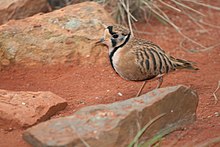Goyder Lagoon
The Goyder Lagoon is a large, not year-round water-filled marshland in the northeast of the Australian state of South Australia .
![]()
It is located northeast of the Birdsville Track near the Queensland border and belongs to the floodplain of the Diamantina River . Particularly high water levels in the Georgina River and the Mulligan River can ensure that water is fed to the swamp on its northwest side via Eyre Creek . The water drains through the Warburton River . Most of the swamp consists of shallow, intertwined, small channels. The area belongs to the Clifton Hills Station cattle station on Crownland .
The average annual rainfall is 100–150 mm and the maximum summer temperatures are 36–39 ° C.
The marshland was named after the geodesist and explorer George Goyder .
Birds
An area of 2,684 square kilometers, including the Goyder Lagoon was developed by BirdLife International for Important Bird Area declared (IBA), mainly because settle there at high tide many waterfowl. In 2002 a total of 170,000 pieces were estimated when counting from the air. The largest concentrations of waterfowl are found in the southern part of the swamp, including various species of cormorants , ducks , herons and ibises . The IBA contains over 1% of the world's monkey ducks ( Stictonetta naevosa ), salmon terns ( Gelochelidon nilotica ) and breeding king spoonbills ( Platalea regia ). A small population of Safrantrugschmätzers (Yellow Chat, Ephthianura crocea ) from the family of honeyeater found in Koonchera Waterhole . Other bird species for which the marsh provides an important habitat are the Schwarzachselaar (Letter-winged Kite, Elanus scriptus ), the belt plover ( Charadrius australis ), the Australian singer brewing grass panties ( Amytornis barbatus ) and Eyregrasschlüpfer ( Amytornis goyderi ), honey-eaters like the mourning honeyeater ( Sugomel nigrum syn. Certhionyx niger ), the Elster honeyeater ( Certhionyx variegatus ) and Gibberbird (Gibber Bird, Ashbyia lovensis ), the Banded Whiteface ( Aphelocephala nigricincta , family acanthizidae ), the Buschflöter (chirruping Wedge Bill, Psophodes cristatus ) and the Zimtflöter (Cinnamon Quail-Trush, Cinclosoma cinnamomeum ).
Individual evidence
- ↑ a b Important Bird Area Factsheet: Goyder Lagoon . BirdLife International (2001)
- ↑ [1]
- ↑ IBA: Goyder Lagoon . In: Birdata . Birds Australia. Retrieved June 28, 2011.
